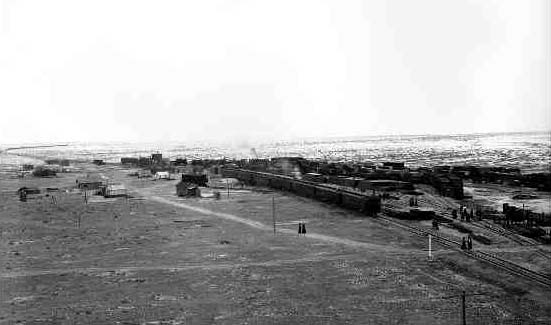
WENDOVER HISTORY

Wendover, UT 1909 (Utah State Historical Society photo)
The above picture taken in 1909 (photographer unknown) depicts Wendover as it was in its early days. One hundred twenty miles west of Salt Lake City, Wendover was established by the Western Pacific Railroad in 1907 as a water, fuel and supply stop for the railroad. It is believed that the town was named for a surveyor working for the railroad, Charles Wendover.
In order to operate their steam engines, the Western Pacific piped water twenty-three miles from Pilot Springs northwest of Wendover. When the railroad began operating diesel-powered engines, they sold the water and two sections of ground to the town of Wendover for $90,000. To make the water fit for culinary use, the city is now in the process of providing two filter ponds. Also, by widening the piping system, more water will be available for business development here and also over the Utah-Nevada state line in West Wendover.
Wendover City is famous for the nearby Bonneville Salt Flats, the 26,000 acres of salt flats where would land speed records have been made; it is also where the crew of the Enola Gay trained before dropping the atom bomb on Japan in 1945. (See Wendover Airbase info)
Water is the key to Wendover; the Nevada side especially has a limited supply. Wendover is also a supply center for ranchers, who range thousands of head of sheep and cattle within a fifty mile radius. Aside from the tourism, employment has been provided for over seventy-five years by the potash industry. In 1988 Kaiser Aluminum and Chemical Corporation sold its plant to Reilly Wendover, which mines and exports well over 100,000 tons of salt, chemicals and fertilizer taken from the salt flats annually. In the 1930's, geologists reported that the salt was 20 feet thick at Knolls some 40 miles to the east of Wendover. Today, because of the 85+ years of flooding the flats and the leaching of salt and chemicals , what now remains of the ancient salt bed is is a small portion northeast of Wendover that is still being leached of salt and chemicals and has endangered the existence of the historic race track. The rest of what was once a bed of salt, is now a grayish brown mud.
Another source of water for the city is Johnson's Springs, thirty-two miles away, which was sold to Wendover City 9 July 1976. This water belonged to Wendover Air Force Base, and part of the base, itself, was transferred to the city 15 August 1977, soon after it had been listed in the National Register of Historic Places. Wendover became a city of the third class 25 March 1982 with a population of 1,099. By 1990 the population reached 1,626 and the town covered 8.5 square miles. The air base today is undergoing civilian development for commercial flights in support of the gambling industry, which boomed in the 1980s on the Nevada side.
The city is situated on an ancient beach of Lake Bonneville, and is snuggled against the Toana Range, which rises 5,000 feet up from the desert floor. To the northwest is the 10,000-foot Pilot Range; and the 12,000 foot Goshute and Deep Creek Ranges to the south. Wendover was incorporated on October 25, 1950 with a population of 400 souls.
In 1845 Captain John C. Fremont passed north of Wendover surveying the country. After crossing the salt desert, his party stopped at the springs of Pilot Mountain, the beacon mountain he named, then continued west over the Pequop and Toana Ranges.
The city's elevation is 4,230 feet, and the mean monthly temperature of Wendover ranges from a maximum of 79 F. in July to a minimum of 27 F. in January, with an annual precipitation of approximately five inches. High summer temperatures and frequent wind create a large evaporation rate.
In 1971, after a public hearing, a design for a section of Interstate 80 was approved which, beginning at the state line and extending east, bypassed Wendover on the north. In 1990, under mayor "Ab" Smith, a ten-acre parcel of land was set aside as the town's first cemetery. Two miles northeast of town in the Silver Island Range, is a major archaeological site that once was home to various prehistoric desert cultures.
The community is served by the Wendover Times and High Desert Advocate newspapers. Wendover was the site of the completion of the first transcontinental telephone line in 1914, and in 1942 an all-weather telephone cable was joined at Wendover.
Excerpts taken from a piece written by: Ouida N. Blanthorn

Wendover, UT 1998 (T.D. Holdeman photo)
Return to Deep Creek - Link to Wendover Airbase